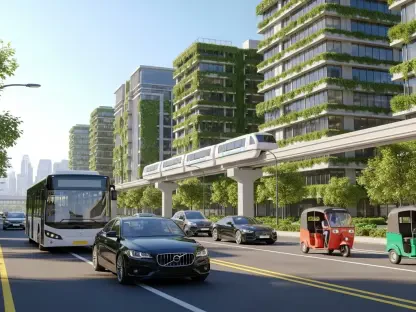Imagine a world where the very buildings that shelter millions could also play a pivotal role in combating climate change, silently pulling carbon dioxide from the air as part of their daily operations. A groundbreaking innovation from researchers at the University of Chicago’s Pritzker School of Molecular Engineering has brought this vision closer to reality with a solar-powered nanofiber filter designed for direct air capture (DAC) of CO2. This technology, seamlessly integrated into standard HVAC systems, promises not only to reduce atmospheric carbon levels but also to enhance energy efficiency and indoor air quality. Unlike traditional methods that rely on massive, centralized plants, this approach decentralizes carbon capture, embedding it into everyday infrastructure. The potential for scalability is staggering, offering a practical solution that could reshape how society addresses one of the most pressing environmental challenges. This development raises intriguing questions about the future of urban design and sustainability.
A New Frontier in Carbon Capture Technology
The core of this innovation lies in a carbon nanofiber-based polyethylenimine (PEI) compound that forms the DAC filter, designed to fit into existing ventilation systems much like conventional air filters. What sets this technology apart is its ability to be regenerated using solar-thermal heating, harnessing renewable energy to ensure sustainability. This eliminates the need for frequent replacements and reduces the environmental footprint associated with disposal. By integrating into buildings’ HVAC setups, the system transforms ordinary structures into active participants in carbon reduction. The concept mirrors the widespread adoption of rooftop solar panels, suggesting a future where carbon capture becomes as commonplace as renewable energy generation. Researchers have crafted a solution that not only addresses atmospheric CO2 but also aligns with the push for greener, more sustainable urban environments, potentially revolutionizing how infrastructure contributes to global decarbonization efforts.
Beyond the technical design, the efficiency of this solar-powered filter stands out as a major advancement. A comprehensive life-cycle analysis reveals an impressive 92.1% efficiency rate, even when accounting for emissions tied to production and eventual disposal. If rolled out across the global building stock, estimates suggest this technology could remove up to 596 megatonnes of CO2 annually—an impact equivalent to taking 130 million cars off the roads. Such figures highlight the scalability of retrofitting ventilation systems as a viable, large-scale strategy for reducing greenhouse gases. The decentralized nature of this approach means that carbon capture could become a distributed effort, with every office, school, and home contributing to a collective environmental goal. This shift in perspective, from isolated industrial solutions to widespread integration, underscores the transformative potential of embedding advanced technologies into the fabric of daily life.
Economic and Health Benefits of Integration
One of the most compelling aspects of this solar-powered DAC filter is the dual advantage it offers in terms of economic savings and health improvements. By capturing CO2 directly indoors, the system reduces the need to heat or cool large volumes of outside air, leading to energy savings of up to 21.66% for households and commercial spaces. This reduction in energy consumption translates into significant cost benefits for building owners and occupants, making the technology an attractive investment beyond its environmental impact. Additionally, the filter enhances indoor air quality, particularly in shared environments like classrooms and offices where ventilation is critical. Cleaner air can lead to better health outcomes, reducing respiratory issues and improving overall well-being. This combination of financial and personal benefits positions the technology as a practical solution that aligns with both individual and societal priorities in addressing climate challenges.
Another layer of value emerges from the operational model proposed for sustaining this system over the long term. Saturated filters could be collected through municipal programs, similar to recycling initiatives, and transported to centralized facilities for CO2 extraction or conversion into valuable chemicals and fuels. This coordinated yet decentralized approach minimizes the need for vast new infrastructure, integrating carbon capture into existing urban systems. The reliance on solar energy for filter regeneration further enhances the sustainability of the model, ensuring that the process remains aligned with renewable energy goals. Such a framework not only makes the technology feasible on a large scale but also embeds it into the rhythm of daily life, normalizing carbon capture as a routine aspect of building maintenance. This vision of seamless integration offers a glimpse into how environmental solutions can evolve to meet modern needs without disrupting established patterns.
Building a Sustainable Future with Urban Infrastructure
Looking ahead, the scalability of this solar-powered filter technology presents an opportunity to redefine urban infrastructure as a cornerstone of global decarbonization. The idea of turning buildings into active carbon sinks challenges traditional notions of environmental action, shifting the focus from standalone facilities to distributed networks of capture points. If implemented widely, this could create a global carbon capture network embedded within the very spaces where people live and work. The consensus among researchers is clear: retrofitting ventilation systems with DAC filters offers a pragmatic path forward, leveraging existing structures to achieve massive reductions in atmospheric CO2. This approach aligns with broader trends in sustainability, where innovation seeks to harmonize with current systems rather than replace them, paving the way for a more integrated and efficient response to climate change.
Reflecting on the journey of this technology, the strides made in merging solar power with carbon capture mark a significant milestone in environmental innovation. The successful development of a filter that balances high efficiency with practical integration into HVAC systems demonstrates a clear path for scaling impact. Economic benefits, coupled with health improvements from better air quality, underscore the multifaceted value of the solution. Looking back, the vision of municipal collection systems and centralized CO2 processing has laid the groundwork for a sustainable operational model. Moving forward, the focus should shift to accelerating adoption through policy incentives and public-private partnerships, ensuring that this technology reaches its full potential. Continued research into optimizing filter materials and regeneration processes will also be crucial, as will efforts to educate communities on the role their buildings can play in shaping a cleaner, healthier planet.









